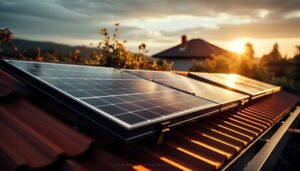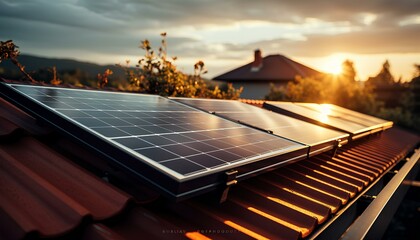Solar panels use the sun’s energy to create electricity, saving you money on your utility bills. They also reduce stress on the power grid, especially during peak demand times.
Solar panels work even on cloudy days by capturing diffused sunlight. They also work better in cooler weather, and some panels have coatings that help them absorb more sunlight. Contact ELLINGSON SOLAR for professional help.
Solar energy is a popular source of renewable power that can reduce your electricity bills and protect the environment. At a basic level, solar panels are comprised of silicon cells that absorb sunlight and create direct current (DC) electricity. They are then connected to inverters, which convert the DC electricity into alternating current (AC) electricity that can be used in appliances.
When it comes to choosing a solar panel system, the most important factor is its efficiency. A higher efficiency rating translates to more energy output for your investment. However, you must balance this with the cost of the solar panel system itself. There are many factors that determine solar panel efficiency, including the type of cell technology and its physical size.
Typically, solar panels are built with either monocrystalline or polycrystalline silicon solar cells. Monocrystalline solar cells are more efficient than polycrystalline, but they also come with a higher price tag. Polycrystalline solar cells, on the other hand, are cheaper but offer similar efficiency levels.
The type of solar panel material will also influence its performance and durability. For example, thin photovoltaic modules with PERC technology are less likely to experience performance degradation over time than traditional silicon-based panels. Thin-film solar cells are also flexible and lightweight, making them suitable for use in applications like windows.
The sun’s radiant energy is converted into electricity by photovoltaic cells, which are housed within a glass casing that protects them from the elements. A back sheet and an insulative layer help prevent heat loss, while bus wires connect the silicon solar cells and carry the electrical current.
Solar panels are most effective in regions with abundant sunshine. They produce more electricity in sunny locations than in cloudy ones, but modern technology enables them to generate a significant amount of energy even in cloudier areas. Solar tracking systems can further enhance energy production by adjusting the panels’ tilt angle seasonally to follow the sun’s path throughout the day.
The physical location of your solar panel installation site also impacts its performance and longevity. High temperatures and humidity reduce the effectiveness of solar panels, while cold climates boost their lifespan. In addition, a tempered glass coating and robust framing materials are essential for durability.
Durable
The durability of solar panels is one of the key reasons why they are such a popular alternative to other energy sources. Solar power produces clean, renewable energy and is an effective way to reduce greenhouse gas emissions. However, solar panels do require some maintenance. If you maintain your solar panels properly, they will last for several decades. They can also boost your home’s resale value. The average homeowner moves every eight years, so installing solar panels will make your home more attractive to the next owner.
The basic construction of a solar panel hasn’t changed much in recent decades. A glass cover and back sheet protect the silicon solar cells inside. The silicon is sliced into thin wafers and soldered to each other with metal connectors. The cells are then arranged in a matrix and sandwiched between an insulation layer and a glass covering. Finally, a junction box and frame finish the panel.
Solar energy systems can be installed at a range of locations, including roofs. The size of a solar array depends on the amount of sunlight your property receives each year. A professional can evaluate your location to determine the ideal number of solar panels to install.
The durability and cost of solar panels depend on the quality of the materials and installation. Choose a reputable provider who offers transparent pricing and will answer all of your questions clearly. Avoid companies that use high-pressure sales tactics or offers that seem too good to be true.
A well-maintained solar panel will produce electricity for decades and may be able to offset some of your utility costs. The solar panel manufacturer typically provides a warranty that covers the panel’s performance and reconditioning. It’s also a good idea to invest in a performance monitoring system, which will allow you to track energy production and spot potential problems.
There are many types of solar energy systems available on the market, each with a unique set of features. Monocrystalline solar panels are the most popular option for homeowners, with a sleek appearance and high efficiency. Polycrystalline solar panels are more affordable than monocrystalline and offer an excellent balance of power output and efficiency. Thin-film solar panels are often used in large-scale installations, such as on commercial buildings or in solar farms. These panels have a thinner profile than monocrystalline and can create a distinctive look for your property.
Affordable
Solar panels are a great way to save money on electricity. Many people use them to power appliances in their home or business. However, they are also used in larger-scale operations such as in solar farms that produce energy for homes and businesses. The cost of solar panels has decreased significantly in recent years. This is due to higher solar panel efficiencies and lower hardware and inverter costs. Combined with financial incentives, these factors make solar energy more affordable than ever before.
A solar panel is a collection of silicon cells that convert sunlight into electric currents through a process known as photovoltaic effect. The panels consist of an insulative layer and back sheet to protect them from excessive heat dissipation and humidity. They are also coated with an anti-reflective coating to improve their performance and ensure maximum sunlight absorption. The system’s metal frame provides support and protection, while the wiring elements include a 12V wire that regulates the amount of electricity sent to the inverter.
Orientation of the solar panel is important for efficient operation. It is best to install them in a south-facing location at an angle of 45 degrees (in the Northern Hemisphere). A north-facing panel will work less efficiently because it can’t absorb as much sunlight.
The type of solar panel matters, too. There are two main types: thin-film and crystalline. Thin-film is the cheaper option, but it doesn’t produce as much power as crystalline solar panels. In addition, it requires more space and may be less durable than crystalline.
Regardless of which type of solar panels you choose, it’s essential to know your household energy usage and peak sun hours to determine the size of your solar system. This will help you figure out how much you need and what your savings will be.
As demand for solar energy increases, developers are experimenting with ways to make it more accessible for low-income households. Some of these new initiatives use community-owned solar, while others involve third-party ownership and virtual net metering. The North Carolina Department of Environmental Quality is working with a diverse group of partners to develop a program that will enable residents of affordable multi-family and supportive housing to go solar. This program will provide meaningful household savings, reduce energy costs, and, when coupled with battery storage, increase resilience for low-income households during grid outages.
Environmentally friendly
Solar power is a clean, renewable, and sustainable energy source. Its environmental benefits extend beyond the planet and to communities that embrace it as an alternative to traditional electricity sources. It reduces greenhouse gas emissions, mitigates climate change, and improves air quality. Solar panels also do not require the use of fossil fuels, which are a finite resource.
Solar panel technology is rapidly improving and becoming more efficient. A typical panel is composed of silicon semiconductors that convert sunlight into usable electricity. Each cell has two silicon sheets sandwiched together: an upper layer infused with phosphorus to retain a negative charge and a lower layer infused with boron to maintain a positive charge. These layers funnel electrons to conductive metals, which then generate electricity. Constant R&D-driven optimization has reduced the amount of material required for a solar panel, and new materials (like perovskites) are increasing efficiency.
While solar panels do have some environmental drawbacks, such as requiring significant amounts of energy and toxic chemicals during manufacturing, they offer many advantages. For example, they are silent and emit no carbon dioxide during operation. Additionally, they do not require transmission lines that can interfere with agriculture or natural habitats.
Besides, solar energy is renewable and offers a limitless supply of clean energy. This makes it a reliable power solution for homes and businesses that want to reduce their reliance on the grid. Additionally, solar power can be paired with batteries to allow people to live off the grid and pursue self-sufficient living.
Eco-friendly solar panels are designed with durable and weather-resistant materials. Their long operational lifespans and low maintenance costs also reduce the need for replacement, further reducing their environmental impact.
In addition, solar panels can be recycled at the end of their lifecycles to produce new solar panels. This minimizes waste, cuts energy consumption, and ensures a steady supply of raw materials. The process also saves water and reduces emissions. Moreover, solar recycling programs help to preserve the environment and protect soil and water resources by diverting materials away from landfills. This is an important step towards achieving sustainability for the future.

